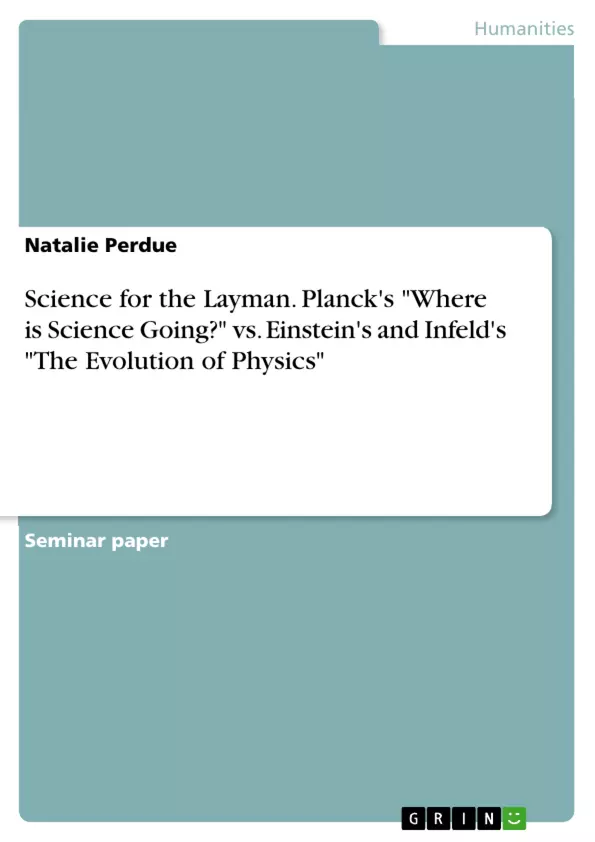Communication between scientists and the public is strained. On one side, scientists are not writing for the lay reader nor making it a priority to disseminate the latest discoveries among average readers; and on the other side, the public is frustrated and distrustful of science’s ever-changing nature, and humans have psychologically evolved to reject information that does not line up with their beliefs.
Planck and Einstein & Infeld address these issues and attempt to bridge the gap in communication between scientists and the public. A close reading of the primary texts shows that the physicists achieved their goal of writing for the layman. Consulting secondary sources such as Tyson’s "Astrophysics for People in a Hurry" and Greene’s "The Elegant Universe" reveals that the science contained in the primary texts is accepted in the modern picture of physics.
An article on the communications gap written by Philip Hunter provides insight into the issues between science writers and the public, and Hunter presents tips on bridging the gap, which Planck, Einstein and Infeld appear to have inherently known. The three physicists address the layman in an attempt to bridge the communication gap between themselves and their peers and the public, and although Einstein and Infeld created a more user-friendly science guide, both texts cover important topics, which are still accepted in physical science, making them vital sources of historical, philosophical, and scientific information.
Inhaltsverzeichnis (Table of Contents)
- Science for the Layman: Planck vs. Einstein & Infeld
- Abstract
- Science for the Layman: Planck vs. Einstein & Infeld
- Where is Science Going?
- The Evolution of Physics
Zielsetzung und Themenschwerpunkte (Objectives and Key Themes)
This paper explores the communication gap between scientists and the general public, analyzing how renowned physicists Max Planck and Albert Einstein, alongside Leopold Infeld, attempted to bridge this gap in their writings. The paper examines how their works, specifically Planck's "Where is Science Going?" and Einstein and Infeld's "The Evolution of Physics," addressed the layman audience and aimed to make complex scientific concepts accessible.
- The communication gap between scientists and the general public
- The historical development of physics and its understanding of the universe
- The nature of scientific inquiry and its limitations
- The role of human perception and the quest for absolute knowledge
- The relationship between scientific laws, human behavior, and moral responsibility
Zusammenfassung der Kapitel (Chapter Summaries)
- Science for the Layman: Planck vs. Einstein & Infeld: This introductory chapter sets the stage by highlighting the challenges in communicating complex scientific concepts to a lay audience. It explores the historical context of science writing and the evolving relationship between scientists and the public.
- Where is Science Going?: Planck's book begins with a historical overview of physics, tracing its evolution from classical to modern understanding. He emphasizes the fundamental principles of reality, including the existence of a reality independent of human knowledge and its non-direct knowability. The chapter then delves into the concept of the Law of Causation and its implications for human agency and moral responsibility. Planck argues that while the Law of Causation influences our actions, it does not excuse our choices. The chapter concludes by discussing the progression of science towards absolute knowledge, acknowledging the limitations of human perception and the pursuit of an ideal goal.
- The Evolution of Physics: Similar to Planck, Einstein and Infeld start their discussion with a historical overview of physics, outlining the transition from relative to absolute understanding. They explain how scientific knowledge moves from being based on human perception to discovering universal principles independent of our earthly observations.
Schlüsselwörter (Keywords)
This paper focuses on the concepts of scientific communication, the history of physics, the philosophy of science, the nature of reality, the Law of Causation, human agency, moral responsibility, and the pursuit of absolute knowledge. The works by Planck and Einstein & Infeld offer insights into the scientific worldview of the early 20th century, highlighting key advancements in physics and their implications for understanding our place in the universe.
- Quote paper
- Natalie Perdue (Author), 2018, Science for the Layman. Planck's "Where is Science Going?" vs. Einstein's and Infeld's "The Evolution of Physics", Munich, GRIN Verlag, https://www.grin.com/document/1312624



